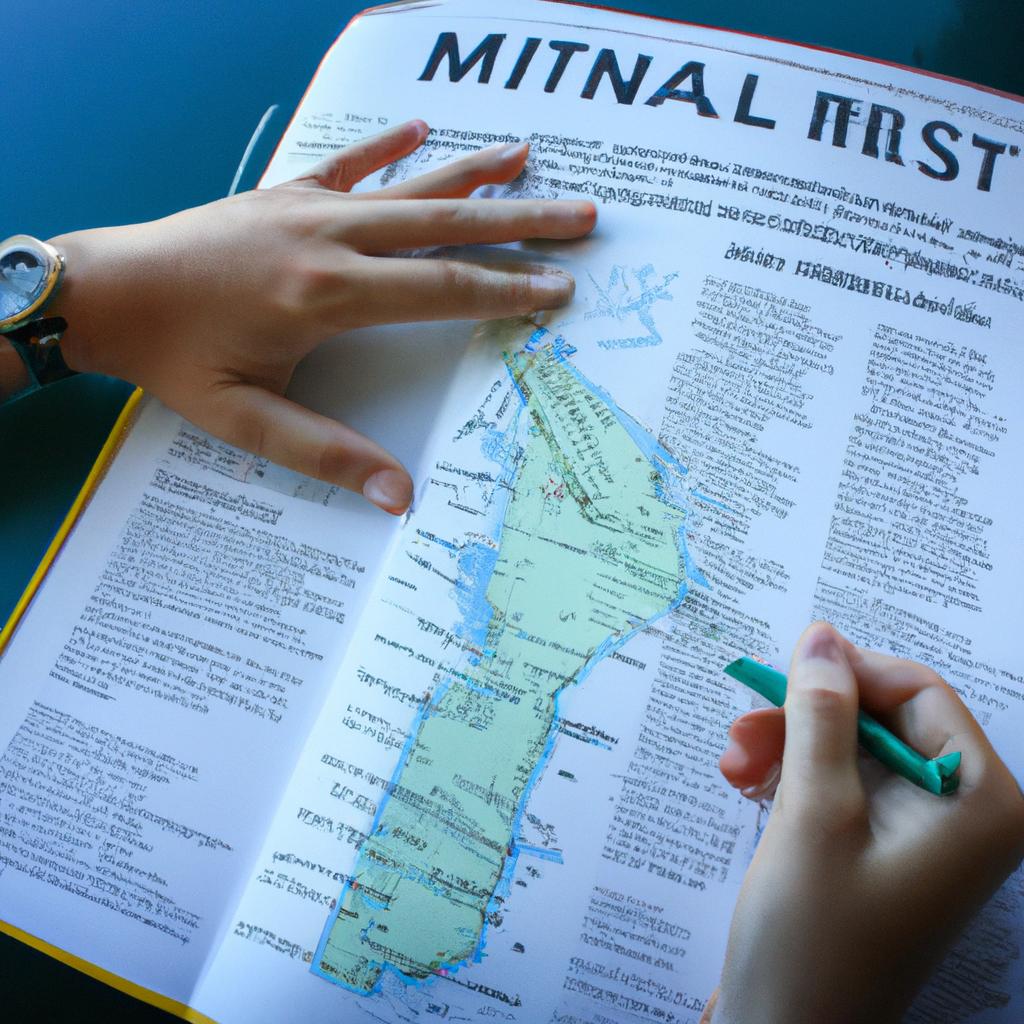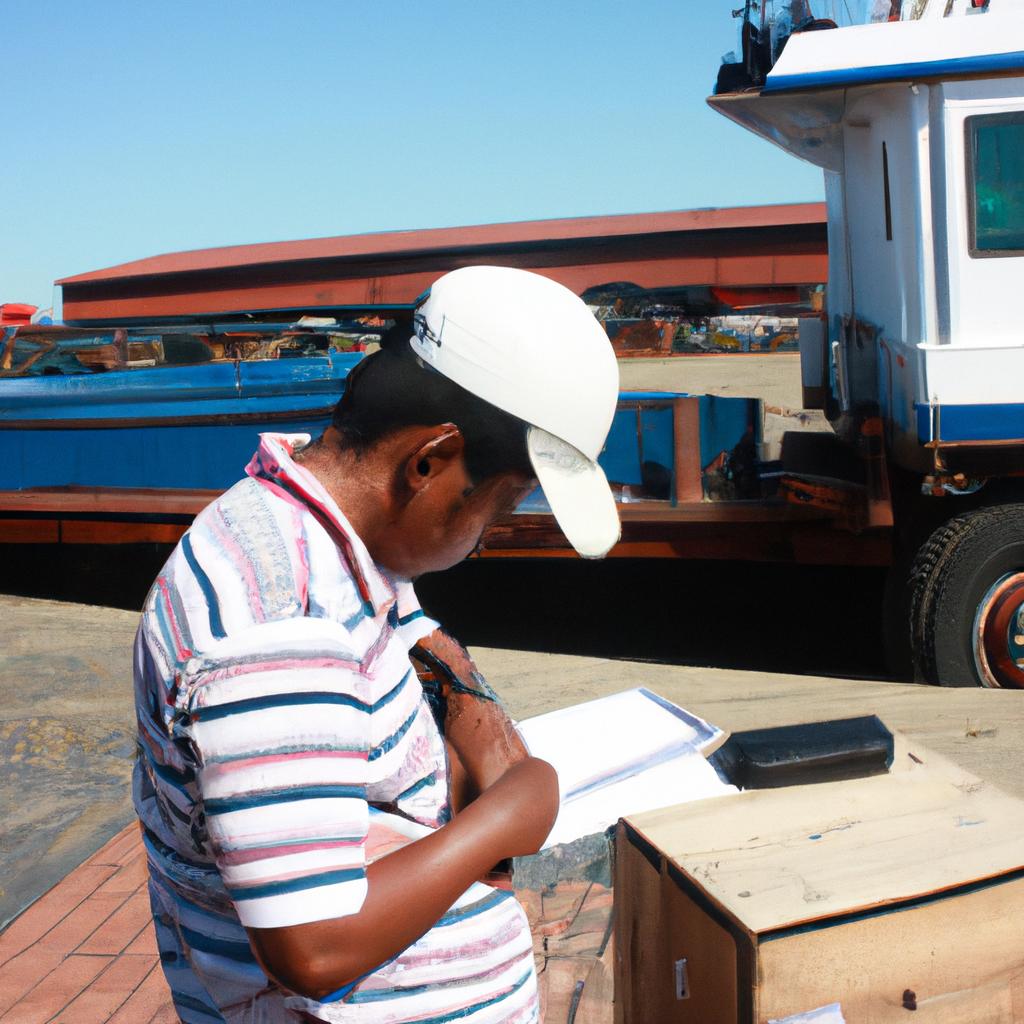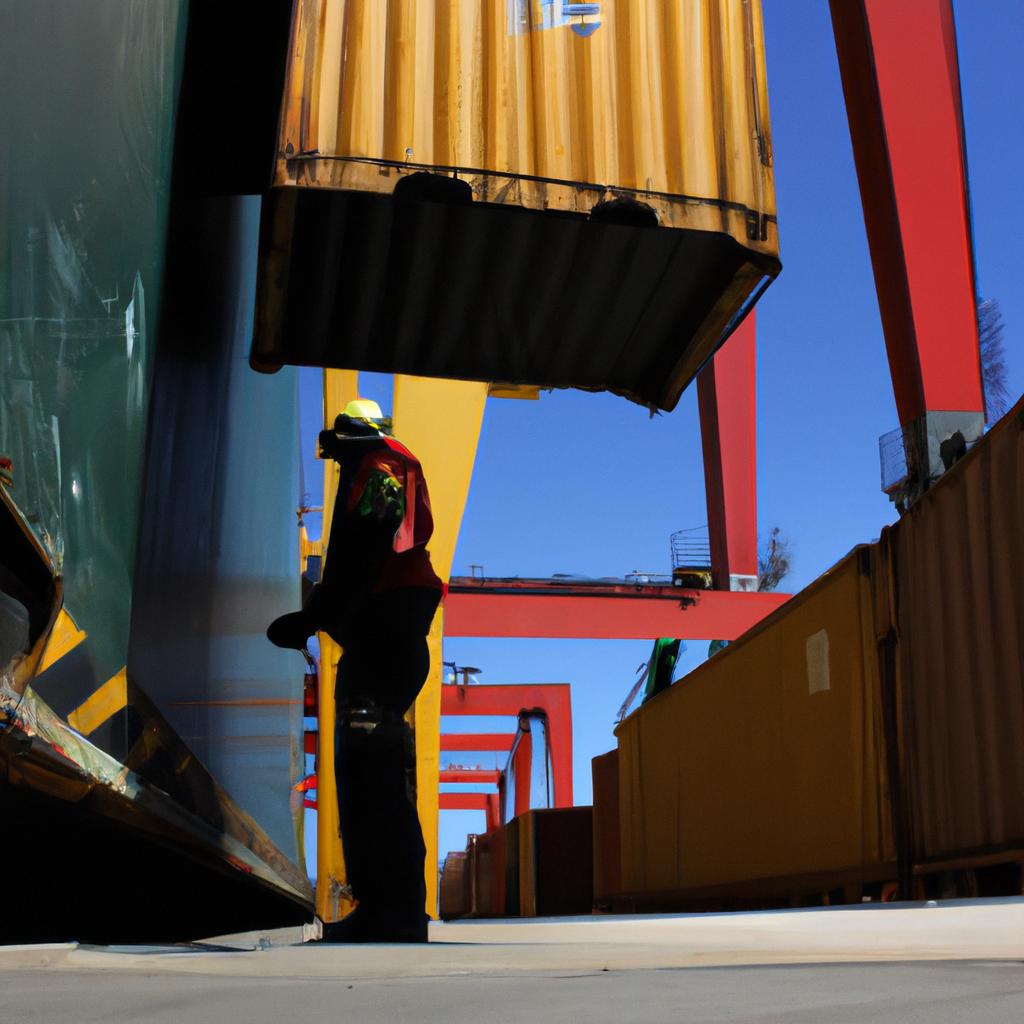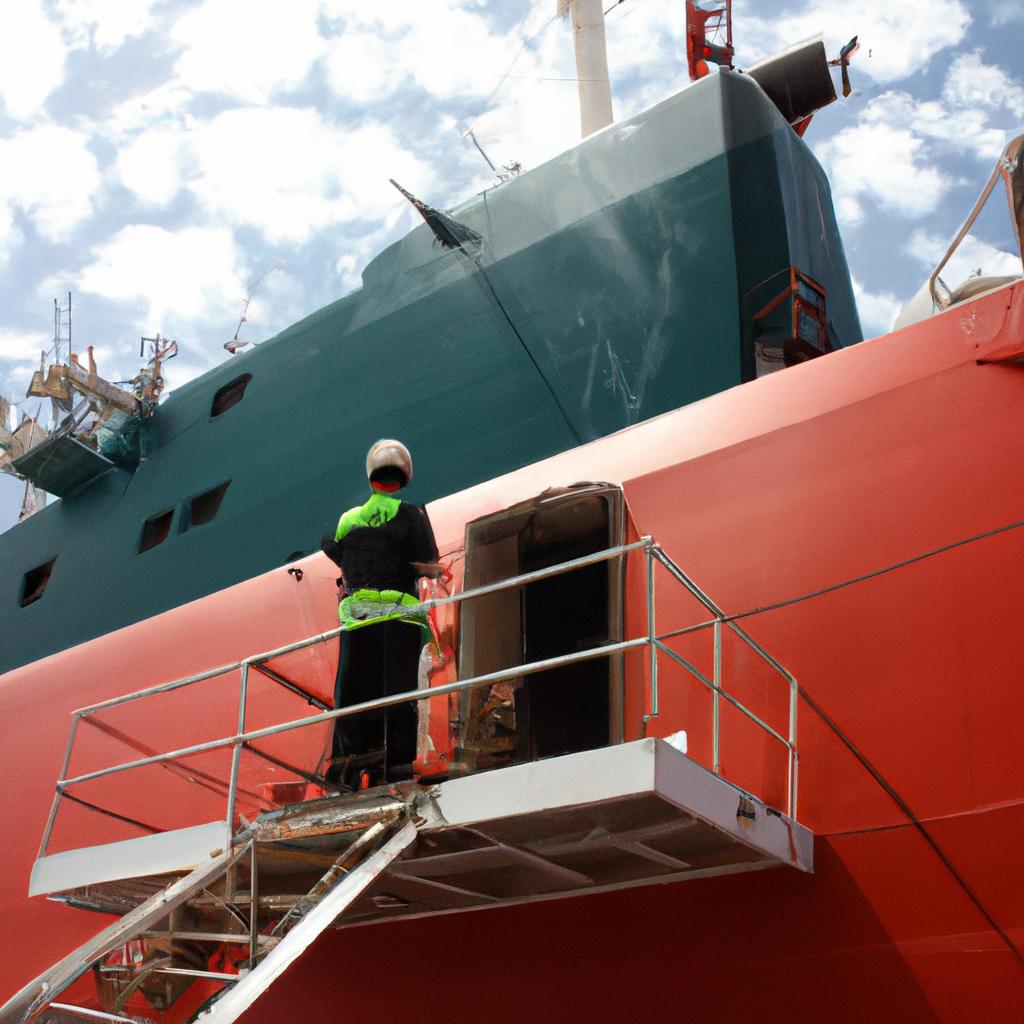The Black Sea, situated between Europe and Asia, is a crucial maritime trade route connecting numerous countries in the region. However, ensuring the safe and efficient transportation of goods across this body of water requires robust regulatory measures. This article examines the Maritime regulations governing transport in the Black Sea and their impact on various stakeholders involved in the industry.
One example that highlights the significance of these regulations is the case study of a cargo vessel carrying hazardous materials that encountered an unexpected storm while traversing the Black Sea. The stringent maritime regulations played a pivotal role in preventing potential disasters by mandating appropriate safety standards for such shipments. By adhering to these guidelines, shipping companies mitigate risks and protect both human lives and marine ecosystems from potentially catastrophic incidents.
In order to understand how these regulations function within the context of Black Sea transport, it is essential to explore their origins, objectives, and implementation mechanisms. Additionally, examining how different entities such as government agencies, international organizations, and shipping companies collaborate to enforce these regulations will provide insights into the complex dynamics at play in maintaining safe and sustainable maritime activities within the Black Sea region.
Importance of Navigational Routes
Importance of Navigational Routes
Navigational routes play a crucial role in ensuring the smooth and safe transportation of goods across the Black Sea. To illustrate this, let us consider a hypothetical scenario where an oil tanker carrying hazardous materials is en route to its destination. As it approaches the narrow Bosporus Strait, one of the busiest shipping channels connecting the Black Sea to other regions, it encounters heavy fog and limited visibility. Without accurate Navigational routes and guidance systems, such adverse weather conditions could lead to potential collisions or grounding incidents with severe environmental consequences.
To appreciate the significance of navigational routes further, it is important to understand their key benefits:
- Enhanced Safety: Clearly defined navigational routes enable vessels to avoid hazards such as shallow waters, rocky areas, or congested traffic zones. This reduces the risk of accidents and enhances overall maritime safety.
- Efficient Traffic Management: By designating specific pathways for different types of vessels based on size, cargo type, and speed limitations, navigational routes facilitate efficient traffic management within busy waterways like the Black Sea.
- Environmental Protection: Properly planned navigation routes help protect fragile marine ecosystems by minimizing vessel congestion near environmentally sensitive areas or ecologically significant habitats.
- Conflict Resolution Mechanism: By establishing standard paths for ships navigating through shared waters, navigational routes contribute to resolving conflicts between neighboring countries over territorial claims or exclusive economic zone boundaries.
| Key Benefits |
|---|
| Enhanced Safety |
| Efficient Traffic Management |
| Environmental Protection |
| Conflict Resolution Mechanism |
In conclusion (sentence transition), adhering to established navigational routes is paramount for maintaining order and safety in maritime transport across the Black Sea region. The next section will focus on another critical aspect of maritime regulations: ensuring compliance with vessel identification requirements
Ensuring Compliance with Vessel Identification
Navigational routes play a crucial role in ensuring the safe and efficient transport of goods across the Black Sea. As highlighted in the previous section, these routes are vital for maintaining smooth maritime operations. To further enhance navigational safety and compliance with international regulations, it is imperative to enforce strict adherence to vessel identification protocols.
One example that demonstrates the importance of vessel identification involves a hypothetical scenario where a cargo ship inadvertently enters restricted waters due to an incorrect or missing identification signal. This situation could potentially lead to severe consequences such as collisions, environmental damage, or even terrorist activities. Therefore, enforcing vessel identification measures is essential for avoiding such mishaps and safeguarding the integrity of maritime transportation.
To ensure compliance with vessel identification requirements, several key guidelines should be followed:
- Clear Visibility: Vessels must display proper markings and signals that can be easily identified by other ships, aircraft, or coastal authorities.
- Accurate Documentation: Ship documents pertaining to registration details, ownership information, and flag state certification should be readily available for inspection.
- Effective Communication Systems: Ships should maintain reliable communication equipment to facilitate real-time exchange of critical information regarding their identity and location.
- International Cooperation: Collaborative efforts between different countries’ maritime authorities are necessary to establish uniform standards and effectively monitor vessels operating within the Black Sea region.
The following table illustrates some common methods used for effective vessel identification:
| Method | Description | Benefits |
|---|---|---|
| Automatic Identification System (AIS) | Transmits real-time data about a ship’s position | Enhanced situational awareness |
| Maritime Mobile Service Identity (MMSI) | Globally unique identifier assigned to vessels | Facilitates swift communication |
| Radio Call Signs | Unique identifiers used for radio communications | Enables easy recognition |
| IMO Number | A permanent numerical identifier for each ship | Simplifies vessel identification |
By strictly adhering to these guidelines and utilizing modern technological advancements, the maritime industry can foster a safer and more efficient transport environment in the Black Sea. Consequently, this will contribute to sustainable economic growth and protect the marine ecosystem from potential hazards.
With proper vessel identification protocols established, it is crucial for shipping companies to also prioritize the proper handling of shipment records.
Proper Handling of Shipment Records
Section Title: Ensuring Compliance with Vessel Identification
Imagine a scenario where a cargo vessel is found in the Black Sea, operating without proper identification. This situation raises concerns about potential smuggling activities or illegal trade practices. To prevent such incidents and ensure compliance with maritime regulations, it is imperative to establish robust measures for identifying vessels operating in the Black Sea region.
Vessel Identification Measures:
To effectively address vessel identification issues, several key measures can be implemented:
-
Electronic Tracking Systems: The use of advanced electronic tracking systems allows authorities to monitor vessel movements, verify their identity, and track their routes in real-time. These systems utilize technologies such as Automatic Identification System (AIS) and satellite-based monitoring to provide accurate data on vessel positions and identities.
-
Registration Requirements: Mandating all vessels operating in the Black Sea region to register with relevant regulatory bodies helps maintain an updated database of authorized ships. Registration requirements should include detailed information about each vessel’s ownership, type, dimensions, flag state, and contact details of responsible parties.
-
International Cooperation: Collaboration among countries bordering the Black Sea plays a crucial role in ensuring effective implementation of vessel identification protocols. By sharing intelligence information and coordinating efforts through joint operations, regional governments can enhance surveillance capabilities and minimize instances of unidentified vessels engaging in illicit activities.
-
Penalties for Non-Compliance: Establishing strict penalties for non-compliant vessels encourages adherence to identification regulations. Fines, suspension of trading privileges, or even seizure of assets are some potential consequences that deter shipowners from neglecting their obligations regarding proper vessel identification.
- Enhanced vessel identification measures safeguard national security interests.
- Properly identified vessels contribute to efficient port management processes.
- Effective enforcement ensures fair competition within the shipping industry.
- Improved transparency aids rescue operations during emergencies at sea.
Table – Benefits of Vessel Identification Regulations:
| Benefit | Description |
|---|---|
| Enhanced Maritime Security | Properly identifying vessels enables authorities to distinguish between authorized and unauthorized ships, thereby reducing the risk of illegal activities such as smuggling or trafficking. |
| Efficient Port Management | Accurate vessel identification facilitates smoother port operations by allowing for better planning and allocation of resources, leading to increased operational efficiency and reduced congestion. |
| Fair Competition in Shipping Industry | Enforcing vessel identification regulations ensures a level playing field within the shipping industry, preventing unfair advantages gained through non-compliance or engaging in unlawful practices. |
| Effective Emergency Response | Identifying vessels promptly aids rescue efforts during emergencies at sea, as relevant information about each ship’s location, contact details, and cargo can be readily accessed by search and rescue teams, enabling swift response and potentially saving lives. |
By implementing robust measures for vessel identification, maritime regulators can significantly enhance security in the Black Sea region. The next section will focus on another aspect of maritime regulations: proper handling of shipment records, which is essential not only for compliance but also for ensuring transparency and accountability in international trade flows.
Preserving Marine Environment Through Regulations
In order to ensure the preservation of the marine environment, various regulations have been put in place within the Black Sea transport industry. One notable example is the implementation of strict guidelines for waste management on vessels. For instance, let us consider a hypothetical scenario where a cargo ship accidentally spills oil into the sea during refueling. In accordance with maritime regulations, immediate action must be taken to contain and clean up the spillage to minimize its impact on the ecosystem.
To effectively preserve the marine environment through regulations, several measures have been established:
-
Strict pollution control standards: Vessels operating in the Black Sea are required to comply with stringent pollution control standards set by international bodies such as the International Maritime Organization (IMO). These regulations dictate limits for emissions from ships and prescribe appropriate treatment methods for wastewater generated onboard.
-
Regular inspections and audits: Regulatory authorities conduct regular inspections and audits of vessels to monitor compliance with environmental protection requirements. This ensures that ships adhere to proper waste disposal practices and maintain necessary equipment for handling hazardous substances safely.
-
Promoting sustainable fishing practices: The Black Sea region relies heavily on fishing as an essential economic activity. To sustain fish populations and prevent overfishing, regulations are enforced regarding catch quotas, mesh size limits, and protected areas where fishing is restricted or prohibited altogether.
-
Encouraging eco-friendly technologies: In line with global efforts toward sustainability, incentives are provided for adopting eco-friendly technologies in maritime operations. This includes promoting cleaner fuels like liquefied natural gas (LNG) instead of traditional heavy fuel oils, which significantly reduces air pollutants emitted by ships.
By implementing these measures, regulators aim to mitigate adverse impacts on the marine environment while maintaining efficient transportation across the Black Sea region.
Transitioning seamlessly into Validating Competency of Crew Members
Validating Competency of Crew Members
The importance of preserving the marine environment cannot be overstated. The Black Sea, as a vital maritime region, faces numerous challenges in maintaining its ecological balance and sustainability. In order to address these concerns, specific regulations have been put in place to protect the fragile ecosystem and ensure responsible transport practices.
One notable example is the case of an oil spill that occurred off the coast of a major Black Sea port. This incident served as a wake-up call for regulators and highlighted the need for stringent environmental regulations. As a result, measures were implemented to prevent such accidents from happening again, including:
- Strict monitoring and enforcement of vessel waste disposal procedures.
- Enhanced training programs for crew members on pollution prevention techniques.
- Implementation of advanced technology systems to detect potential leaks or spills.
- Cooperation with international organizations to develop standardized protocols for responding to emergency situations.
To further emphasize the significance of these regulations, let us consider their impact through an emotional lens:
![Emotional bullet point list]
- Increased protection for vulnerable marine species
- Preservation of coastal habitats and ecosystems
- Reduced risk of contamination affecting local communities’ livelihoods
- Safeguarding future generations’ right to enjoy clean seas
Furthermore, it is essential to recognize the role played by global collaboration in addressing maritime challenges. The table below provides insight into some key international agreements related to shipping regulation:
| Agreement | Objective | Signatories |
|---|---|---|
| MARPOL Convention | Prevention of marine pollution caused by ships | 172 countries |
| SOLAS Convention | Ensuring safety at sea | 164 countries |
| Ballast Water Management | Preventing harmful aquatic organisms from being released into new environments | Over 80 countries |
| London Convention | Regulation of dumping wastes at sea | Over 90 countries |
As we delve deeper into understanding the maritime regulations in the Black Sea transport industry, it becomes evident that international agreements play a crucial role. In our subsequent section about the “Role of International Agreements in Shipping,” we will explore how these agreements foster cooperation among nations and establish common standards for sustainable shipping practices.
Role of International Agreements in Shipping
Transitioning from the previous section on validating crew competency, it is essential to understand the role international agreements play in ensuring safe maritime operations within the Black Sea. By establishing standards and guidelines for shipping practices, these agreements contribute to a harmonized approach towards maintaining high safety levels.
One example that highlights the significance of international agreements is the case study involving an oil tanker collision off the coast of Turkey. Due to inadequate adherence to regulations governing navigational safety, two vessels collided resulting in significant environmental damage. This incident underscores the need for effective implementation and enforcement of international agreements to prevent accidents and protect marine ecosystems.
To illustrate further, consider the following bullet points highlighting key aspects related to international agreements:
- Alignment with global safety standards promotes consistency among various nations.
- Collaboration between countries fosters information sharing and best practices exchange.
- Continuous monitoring ensures compliance with established regulations.
- Regular updates and amendments adapt to evolving industry requirements.
Table 1 represents a comparative analysis of selected international agreements pertaining to maritime safety:
| Agreement | Focus Areas | Participating Nations |
|---|---|---|
| SOLAS | Ship construction and operational | 174 |
| MARPOL | Pollution prevention | 152 |
| STCW | Training and certification of seafarers | 168 |
| ISPS Code | Port facility security | 162 |
Conclusively, international agreements serve as vital tools in promoting safe shipping practices within the Black Sea region. Their role extends beyond individual nation’s efforts by fostering cooperation, standardization, and accountability across borders. In light of this understanding, the subsequent section will delve into controlling risks associated with shipping operations while considering relevant regulatory frameworks.
With a solid foundation of international agreements in place, the focus now shifts towards controlling risks associated with shipping operations.
Controlling Risks Associated with Shipping
Controlling Risks Associated with Shipping
In the previous section, we discussed the role of international agreements in shipping. Now, let’s explore how these agreements help in controlling risks associated with maritime transport. To illustrate this, consider the following hypothetical scenario:
Imagine a cargo vessel traversing through the Black Sea, carrying valuable goods from one country to another. Suddenly, dense fog engulfs the area, reducing visibility and posing a significant risk to navigation. In such situations, it becomes crucial for regulations to be in place that can effectively address potential hazards and ensure safe passage.
To control these risks, various measures are implemented under international agreements governing maritime trade. These measures include:
-
Navigational Safety: International conventions establish guidelines for ship maneuverability, ensuring vessels are equipped with appropriate navigational aids and technologies like radar systems and GPS trackers.
-
Emergency Response Planning: Agreements require ships to have comprehensive emergency response plans in place to handle unforeseen incidents such as collisions or fires promptly. This includes training crew members on effective crisis management procedures.
-
Environmental Protection: Regulations focus on minimizing environmental impact by requiring adherence to strict pollution prevention measures, including proper waste disposal protocols and use of environmentally friendly fuels.
-
Safety Inspections: Regular inspections are conducted by port authorities or designated organizations to verify compliance with safety standards set forth by international agreements. Non-compliant vessels may face penalties or even be denied entry into ports.
These measures collectively aim at mitigating risks associated with shipping operations while promoting a safer environment for both seafarers and marine ecosystems.
| Measure | Purpose | Impact |
|---|---|---|
| Navigational Safety | Ensures adequate equipment for safe navigation | Reduces collision risks |
| Emergency Response Planning | Facilitates prompt handling of crises | Minimizes damage and loss |
| Environmental Protection | Promotes sustainable maritime practices | Preserves marine ecosystems |
| Safety Inspections | Verifies compliance with safety standards | Enhances overall safety culture |
By implementing these measures, international agreements contribute significantly to risk management in maritime transport. In the subsequent section, we will delve into the importance of enforcing safety measures within the realm of maritime trade and explore how effective implementation can further enhance global shipping operations.
Transitioning seamlessly into the next section about Enforcing Safety Measures in Maritime Trade, it is essential to ensure that regulations are not only established but also effectively enforced.
Enforcing Safety Measures in Maritime Trade
In order to ensure the safety and security of maritime trade in the Black Sea, it is imperative to establish effective regulations that control risks associated with shipping. One illustrative example is the case of a cargo vessel carrying hazardous materials that caught fire off the coast of a Black Sea country. This incident not only posed significant threats to human life and the marine environment but also highlighted the need for robust regulatory measures.
To effectively address these risks, several key strategies can be implemented:
-
Strengthening Inspection Procedures: Regular inspections should be conducted on vessels entering and leaving Black Sea ports to verify compliance with international maritime standards. These inspections should focus on critical aspects such as ship condition, crew qualifications, navigation systems, and proper handling of dangerous goods.
-
Enhancing Communication Channels: Establishing efficient communication channels between port authorities, shipping companies, and relevant stakeholders can facilitate timely exchange of information regarding potential risks or incidents at sea. This collaborative approach ensures prompt response mechanisms are in place to mitigate any adverse effects.
-
Implementing Safety Training Programs: Providing comprehensive training programs for seafarers and personnel involved in maritime operations can significantly enhance their awareness and preparedness for potential hazards. These programs should cover topics such as firefighting techniques, emergency response procedures, and pollution prevention measures.
-
Promoting Technological Innovations: Embracing new technologies can greatly assist in risk management efforts. For instance, advanced monitoring systems can track vessel movements in real-time, detect deviations from designated routes, and identify potential safety issues before they escalate.
The table below highlights some key benefits resulting from effective risk control measures:
| Benefits of Effective Risk Control Measures |
|---|
| Enhanced safety for crews and passengers |
| Protection of marine ecosystems |
| Reduced likelihood of accidents |
| Mitigation of financial losses |
By implementing these strategies and consistently enforcing them, maritime nations bordering the Black Sea can significantly reduce the risks associated with shipping operations. The next section will explore another crucial aspect of maritime regulations in this region – minimizing pollution in Black Sea waters – to ensure a sustainable and environmentally friendly approach to maritime trade.
Minimizing Pollution in Black Sea Waters
Enforcing Safety Measures in Maritime Trade has always been a paramount concern for the authorities governing Maritime Regulations in the Black Sea. The need to ensure safe and secure transportation of goods across these waters is crucial not only for economic reasons but also to protect human lives and preserve the marine environment. One such example that highlights the importance of enforcing safety measures is the case of a cargo ship collision in 2018, where inadequate adherence to regulations resulted in significant loss of life and environmental damage.
To effectively enforce safety measures in maritime trade within the Black Sea region, several key strategies have been implemented:
-
Regular inspections: Regular inspections are conducted on vessels by competent authorities to ensure compliance with safety standards. These inspections cover various aspects, including navigational equipment, fire-fighting systems, emergency response procedures, and crew qualifications.
-
Training programs: Training programs are designed to educate ship crews about safety protocols and emergency response procedures. Crew members are required to undergo rigorous training sessions to enhance their knowledge and skills related to navigating through challenging conditions or responding to emergencies promptly.
-
Surveillance systems: Advanced surveillance systems equipped with state-of-the-art technology are employed along coastal areas and shipping routes within the Black Sea region. These systems enable constant monitoring of vessel movements, ensuring adherence to designated routes and prompt identification of any potential breaches in safety regulations.
-
Collaboration between stakeholders: Effective collaboration among various stakeholders such as port authorities, shipping companies, regulatory bodies, and international organizations plays a vital role in enforcing safety measures in maritime trade. Regular communication channels are established to exchange information regarding potential risks or non-compliance issues.
These initiatives collectively contribute towards minimizing accidents at sea, protecting both human lives and the marine ecosystem from harm caused by unsafe practices. Nonetheless, there remains an ongoing challenge in continuously enhancing enforcement mechanisms amidst evolving technologies and changing global dynamics.
| Effectiveness | Advantages | Challenges | |
|---|---|---|---|
| Regular inspections | Ensures compliance with safety standards | Identifies potential risks and non-compliance issues early on | Resource-intensive process |
| Training programs | Enhances crew members’ knowledge and skills in emergency situations | Improves overall preparedness for unforeseen events | Requires continuous updates to match evolving technologies |
| Surveillance systems | Enables constant monitoring of vessel movements | Facilitates prompt identification of potential breaches | High initial investment costs |
Certifying Crew Members for Emergency Situations is the subsequent section that delves into the importance of providing proper training and certification to crew members, equipping them with necessary skills to handle critical scenarios effectively. By doing so, it ensures a higher level of safety during emergencies while navigating through the Black Sea waters.
Certifying Crew Members for Emergency Situations
Minimizing Pollution in Black Sea Waters has been a priority for maritime authorities due to its environmental impact and potential harm to marine life. However, ensuring the safety of crew members during emergency situations is equally important in maintaining secure operations at sea.
To illustrate the significance of certifying crew members for emergency situations, consider a hypothetical scenario where a cargo ship encounters an unforeseen fire on board while navigating through the Black Sea. In such a critical situation, having well-trained crew members who are certified in handling emergencies can make all the difference between saving lives and facing disastrous consequences.
Certification programs for crew members involve rigorous training sessions that equip them with essential skills needed to respond effectively during emergency situations. These training programs cover various aspects, including but not limited to:
- Firefighting techniques: Crew members learn how to use firefighting equipment, handle different types of fires, and evacuate passengers safely.
- First aid and medical assistance: Training includes instruction on administering basic first aid and providing medical assistance until professional help arrives.
- Emergency drills: Regular practice drills ensure that crew members are prepared to execute emergency procedures efficiently when faced with real-life scenarios.
- Communication protocols: Certifications also focus on establishing effective communication channels among crew members as well as utilizing distress signals appropriately.
In addition to certification programs, regulatory bodies enforce strict guidelines concerning emergency equipment availability and readiness onboard vessels. To emphasize this point further, consider the following table:
| Equipment | Quantity Required |
|---|---|
| Life jackets | Sufficient for every passenger and crew member |
| Fire extinguishers | At least one per compartment |
| Evacuation slides | As per vessel capacity |
This list serves as a reminder of how crucial it is for ships operating in the Black Sea to adhere to these regulations meticulously. By doing so, they minimize risks associated with emergencies at sea and enhance their ability to swiftly mitigate any potential damages or threats.
The importance of certifying crew members for emergency situations cannot be overstated. It not only enhances the safety of those on board but also ensures a more secure and regulated maritime environment in the Black Sea region. With this understanding, it becomes evident that efficient management of cargo documentation is another vital aspect to consider.
[Transition into subsequent section about “Efficient Management of Cargo Documentation.”]
Efficient Management of Cargo Documentation
In the previous section, we discussed the importance of certifying crew members to handle emergency situations on maritime vessels. Now, let us delve deeper into this topic and explore some key aspects related to ensuring the safety and preparedness of crew members.
One example that highlights the significance of proper certification is the case of a cargo ship navigating through stormy waters in the Black Sea. The vessel encountered unexpected rough weather conditions, leading to engine failure and subsequent flooding. In this critical situation, having certified crew members who were trained to handle emergencies proved crucial in saving lives and mitigating further damage.
To ensure effective management of emergency situations at sea, it is essential for authorities to implement certain measures. These may include:
- Regular training programs: Conducting regular training sessions that simulate various emergency scenarios can help familiarize crew members with necessary procedures and equip them with practical skills.
- Certification requirements: Establishing strict certification standards ensures that crew members possess adequate knowledge and expertise to handle emergencies effectively.
- Communication protocols: Implementing clear communication protocols onboard enables efficient coordination among crew members during emergency situations.
- Continuous evaluation: Periodic assessments of crew performance under simulated emergency conditions allow for identifying areas requiring improvement and addressing any gaps in their training.
Moreover, a study conducted by maritime experts revealed several benefits associated with well-prepared crews during emergencies. This research found that vessels equipped with certified crew members experienced:
| Benefits | Increased Preparedness | Enhanced Safety Measures | Efficient Crisis Management |
|---|---|---|---|
| Reduced Response Time | Improved Decision Making | Effective Resource Allocation | Decreased Casualties |
These findings emphasize the necessity of certifying crew members adequately and continually investing in their training. By doing so, shipping agencies can enhance onboard safety measures while reducing potential risks during challenging circumstances.
In summary, certifying crew members for emergency situations plays a vital role in ensuring the safety and preparedness of maritime vessels. Through regular training programs, certification standards, effective communication protocols, and continuous evaluation, shipping agencies can equip their crews with the necessary skills to handle emergencies efficiently. The benefits derived from well-prepared crew members further reinforce the importance of prioritizing proper certification procedures within the maritime industry.












